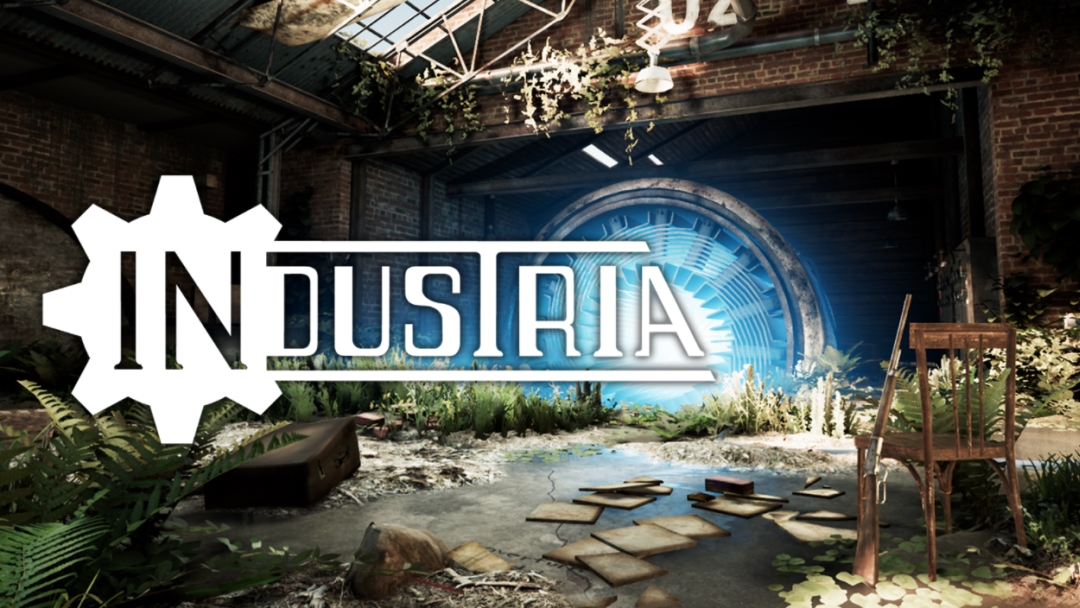
It may not explicitly market itself as such, but INDUSTRIA feels like a retro-inspired shooter drawing upon themes and mechanics from past PC games.
Typically when we think of retro-inspired shooters, we tend to think of games like Ion Fury, Wrath: Aeon of Ruin, Amid Evil, or Dusk. These all try to replicate the look and feel of Quake, Doom, Wolfenstein, HeXen, or other boomer shooters that dominated the ’90s and early ’00s.
INDUSTRIA takes another approach by mimicking the atmosphere and mechanics of a different type of shooter that has largely been abandoned in recent years: the linear narrative-driven FPS. Exemplified by the Half-Life series, such shooters usually focus a bit more on the narrative and lore as you navigate fairly linear levels, with the occasional puzzle or two to break up the shooting bits.
It’s easy to make Half-Life comparisons when describing INDUSTRIA; and not just because both games are about a scientist that suddenly finds themselves in an unfamiliar world after some science techno-magic goes wrong.
INDUSTRIA even features some physics-based box stacking puzzles, an archaic concept that feels quaint in an FPS in 2021. While INDUSTRIA has plenty of things going in its favor, it also has a few problems that get in the way of the experience.
INDUSTRIA
Developer: Bleakmill
Publisher: Headup
Platform: Windows PC
Release Date: September 30th, 2021
Players: 1
Price: $19.99 USD

INDUSTRIA opens the evening of November 9th, 1989; the day the Berlin Wall was breached and the two Germanys took the first steps toward reunification. You play as Nora, a scientist in East Berlin working on a secretive project called ATLAS, that involves advanced AI and alternate dimensions.
As history unfolds on national television, Nora is awakened by a cryptic call from her colleague, Walter. The Stasi are dismantling the ATLAS facility in a frantic attempt to destroy as many top secret projects and documents as possible, before they fall into the hands of the Western powers.
After a short walk to the ATLAS facility, it quickly becomes apparent than things have gone very wrong. The facility is completely abandoned, and ATLAS itself is overloading, with the interior of the building shaking and crumbling.
With Walter nowhere to be found, Nora comes to the conclusion that he managed to slip into another dimension; a feat that was thus far limited to objects and small test animals, with extremely mixed results. Nora decides to follow Walter, determined to find him on the other side and bring him back.
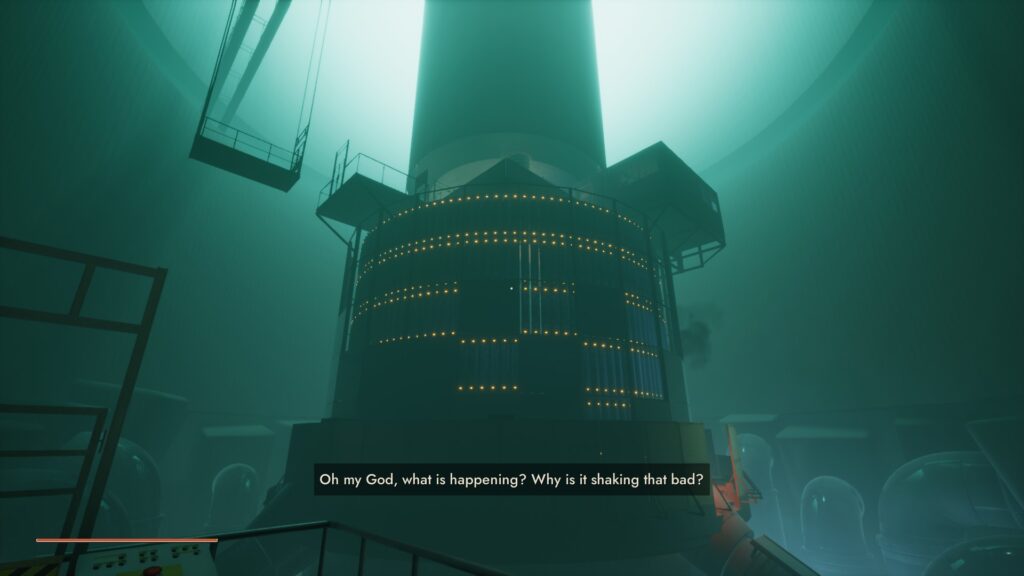
The alternate dimension she now finds herself in consists of a world where robots wonder aimlessly around a version of Berlin that has been abandoned by humanity. With the help of a lone survivor still living in the empty ruins of this once prosperous city, Nora will need to navigate this unfamiliar and hostile world; as she tracks down clues to Walter’s fate, and uncovers the mysteries surrounding what caused the robot uprising.
As a slower, more narrative heavy experience, a lot of your time in INDUSTRIA will consist of exploring the abandoned city’s empty streets and apartments. The game’s levels are very linear, with some hidden nooks and crannies that contain useful resources, like health vials and ammo.
The mysterious man you meet early on keeps in touch over a radio, providing you with story development and a guide on your journey. As I briefly mentioned earlier, INDUSTRIA has a few puzzles scattered around that must be solved to progress.
These mostly consist of finding hidden levers, or stacking boxes and other bits of debris to reach higher areas. Occasionally, you’ll get a more creative puzzle based around rudimentary inventory management.
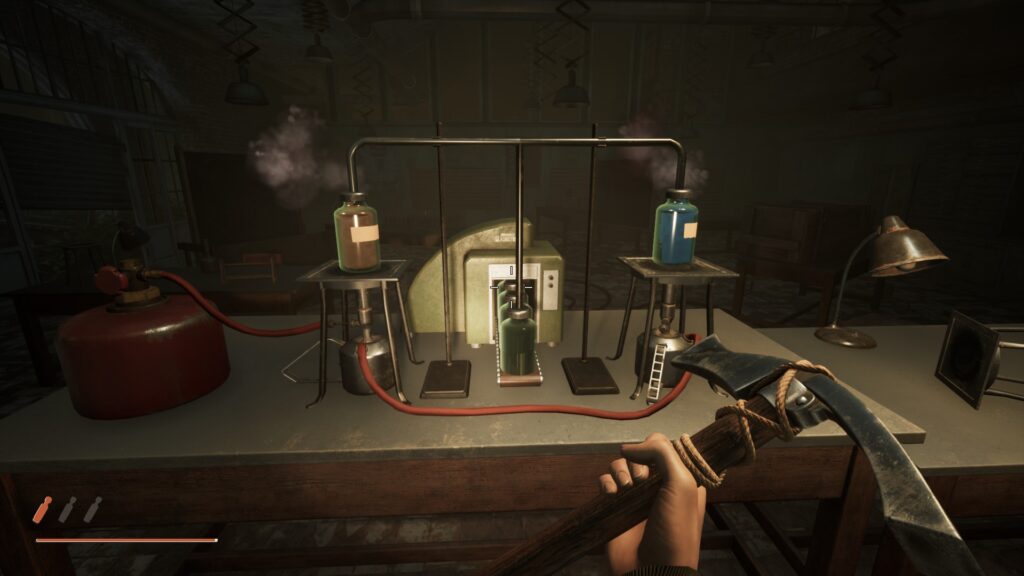
One of these puzzles early on involves a rusty valve that you can’t turn. Luckily, there is a chemistry set nearby, along with a chalkboard containing a handy recipe for a rust remover. Find canisters of the right chemicals to combine them at the chemistry set, and your new rust remover can be used on the valve. Other such inventory puzzles involve finding valves, or some other key required to open a door.
INDUSTRIA‘s experience is primarily about immersing yourself in the game’s world and unraveling its story. The environment is littered with various hidden diaries or notes that help you piece everything together. Even still, there are lots of elements that are left open to interpretation.
In this regard, piecing together the lore the game provides you, and speculating to fill in the gaps, is one of INDUSTRIA‘s main highlights. The game has a fairly interesting story and setting, which is why I’ve tried to keep most of it as vague as possible here.
Of course, exploration is far from the only gameplay focus of INDUSTRIA. This is an FPS after all, so there are plenty of enemies to shoot. There’s about six enemy types throughout the game, and you’ll be shooting them with an arsenal of four guns. A pistol, an SMG, a shotgun, and a sniper rifle. You also have a pickaxe, though ammo is plentiful enough that you won’t be using it much later in the game.
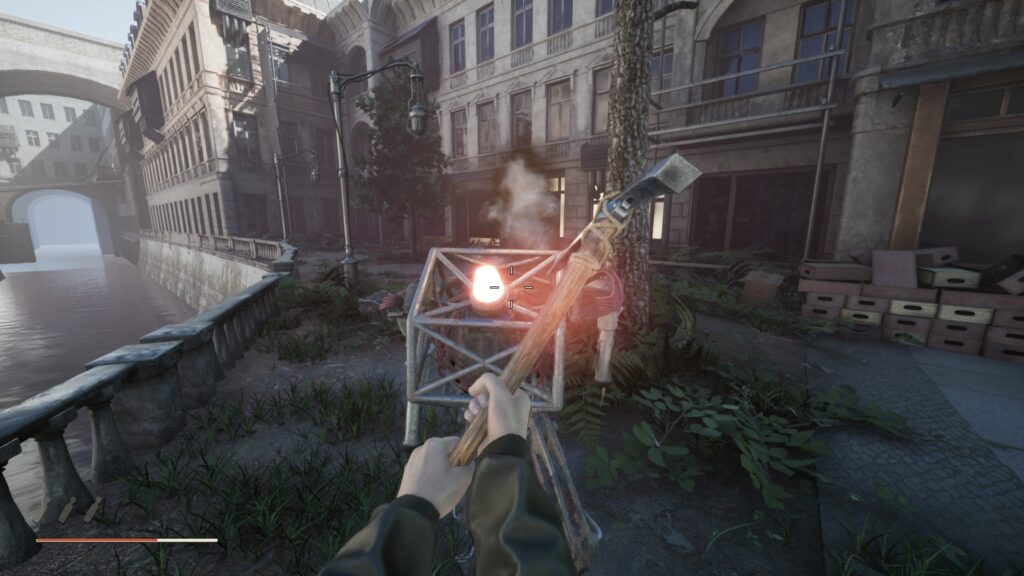
INDUSTRIA‘s shooting mechanics can best be described as functional and adequate. Robots are always hard to balance as a satisfying enemy to shoot, and some of the robots in INDUSTRIA are definitely more fun to destroy than others. The more humanoid types have some basic locational damage, allowing you to blow off limbs. Some of the others just kind of fall down with some janky ragdoll physics when killed.
If you are looking for a challenging FPS experience with tons of variety though, you really won’t get that here. Anyone even moderately experienced in shooters shouldn’t have any trouble getting through the game on the default difficulty without dying even once.
There is a more “hardcore” mode where ammo and health vials are more scarce, though it doesn’t really make the enemies smarter or harder to kill. This mode also removes quick saves, making you instead rely on typewriters to save your progress.
Most of the robots have AI patterns that largely consist of “charge towards player.” Some of the robots are slow, some of them are fast, and one type self-destructs when they get to you; but in general they all react roughly the same when they detect you.
There is only one type of ranged enemy in the game, and they are fairly few and far between. They also aren’t too great at the whole taking cover thing, so they aren’t especially hard to dispatch.
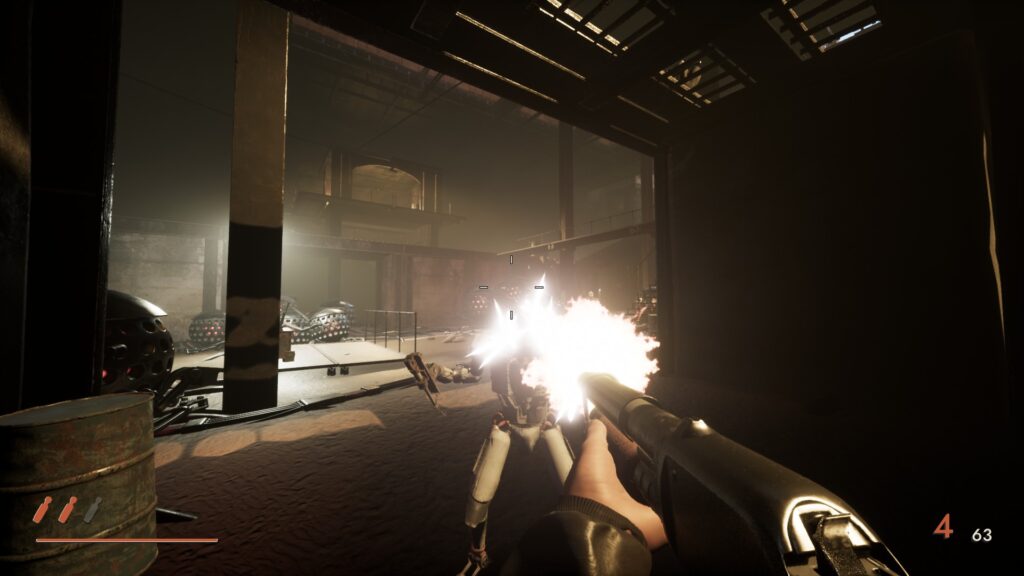
While the enemy and weapon variety is pretty anemic, something to bear in mind is that INDUSTRIA can be completed within four hours. My first playthrough clocked in at 3.3 hours, and I got 15 of the game’s 21 achievements.
As a story focused game, there isn’t really a reason to replay it unless you want to grab any achievements you missed. Even then, that likely won’t add more than about two or three hours to the total playtime.
Game length is one of those things that people can have wildly different opinions on. In INDUSTRIA‘s case, I feel the game length is fine for the story and experience the developers were trying to tell. For some people though, I can see a sub-four hour experience for $20 USD being a sticking point.
From a performance standpoint, INDUSTRIA has some issues. While I admit that I’m on an ancient machine that still runs a 1070, the framerate was still pretty inconsistent for what you’d expect from an indie game with modest visuals. It wasn’t uncommon for the game to dip below 60 FPS, and people with far beefier rigs have expressed similar complaints.
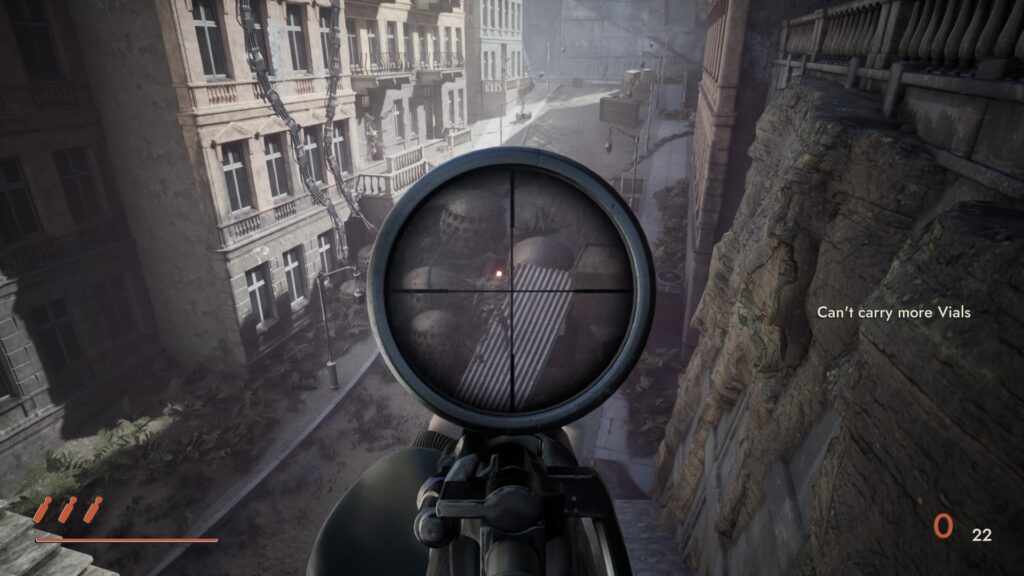
Visual and graphical bugs are moderately common as well. In the first outdoor level, the game’s shadows kept flickering really badly. It wasn’t long after this that the game crashed, but upon reloading it the shadow flickering had resolved itself.
In another outdoor level, all the grass was illuminated like I stepped into a radioactive wasteland. There are also a few locked doors that you can actually pass through, giving you a lovely view of the underside of the level.
INDUSTRIA is certainly a flawed game, but it still manages to be a charming little homage to Half-Life and other story-driven shooters from the time. It has an interesting story and setting that invites you to piece together clues and reach your own conclusions, and the characters are likeable and well voice acted.
The shooting mechanics might not be as refined or satisfying as other FPS games on the market, but they get the job done. If you don’t mind the short length and minor technical issues, INDUSTRIA is a fairly enjoyable experience that you can complete in a single session.
INDUSTRIA was reviewed on Windows PC using a review code provided by Headup. You can find additional information about Niche Gamer’s review/ethics policy here.